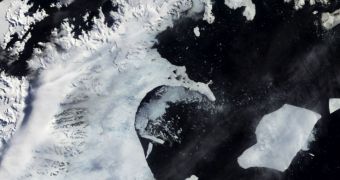When the Larsen A and B ice shelves collapsed in 1995 and 2002, respectively, experts were on the scene to observe the Antarctic decline. Now, a new study quantifies just how much ice was lost following the collapse of these two ice masses.
The ice shelves were located in East Antarctica, and experts have been warning that they are about to collapse for years before each of the two incidents. Since they actually happened, experts have been using the instances as a means to study ice motions in more detail.
They say that the loss of the sea-based Larsen shelves is devastating for the area. The land-based glaciers that were kept at bay by these ice walls are now free to flow into the Southern Ocean.
What the international research team behind this investigation was interested in was learning how much of the land-based ice had been lost as a result. The results may also be used to fine-tune models of how climate change will affect this region in the future.
Such studies are critical because Antarctica, together with the Arctic and Greenland, contain the larges portion of the world’s ices. They are also the most likely to be affected by climate change, due to the fact that the effect is felt more at higher latitudes.
The research team included experts from the University of Maryland in Baltimore County (UMBC), the University of Colorado National Snow and Ice Data Center (NSIDC) and the University of Toulouse, in France.
“Not only do you get an initial loss of glacial ice when adjacent ice shelves collapse, but you get continued ice losses for many years – even decades – to come. This further demonstrates how important ice shelves are to Antarctic glaciers,” says Christopher Shuman.
The expert – who is also the lead author of the work – is based at the NASA Goddard Space Flight Center (GSFC) /UMBC Joint Center for Earth Systems Technology (JCET). Details of the work appear in the July 25 online issue of the Journal of Glaciology.
From 2001 to 2006, East Antarctica lost as much as 11.2 gigatons (11.2 billion tons) of ice annually, and the decline is continuing. Some glaciers decreased by as much as 500 feet per year.
Data covering the period from 2006 to 2010 show an average loss of 10.2 gigatons (10.2 billion tons) of ice per year.

 14 DAY TRIAL //
14 DAY TRIAL //